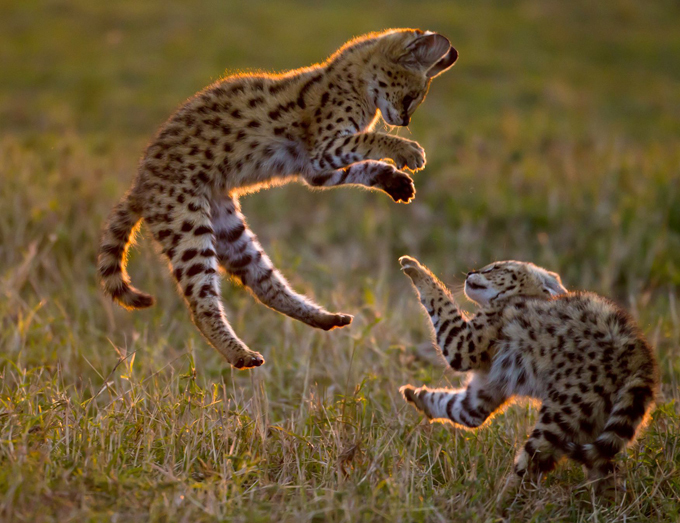Felines on the brink of extinction

The Maltese tiger, or blue tiger, is a reported but unproven coloration morph of a tiger, reported mostly in the Fujian Province of China. It is said to have bluish fur with dark grey stripes. Most of the Maltese tigers reported have been of the South Chinese subspecies. The South Chinese tiger today is critically endangered, due to their illegal and continued use in traditional Chinese medicine and the "blue" alleles may be wholly extinct. Blue tigers have also been reported in Korea.
The Maltese tiger, or blue tiger, is a reported but unproven coloration morph of a tiger, reported mostly in the Fujian Province of China. It is said to have bluish fur with dark grey stripes. Most of the Maltese tigers reported have been of the South Chinese subspecies. The South Chinese tiger today is critically endangered, due to their illegal and continued use in traditional Chinese medicine and the "blue" alleles may be wholly extinct. Blue tigers have also been reported in Korea.

The margay (Leopardus wiedii) is a small cat native to Central and South America that is listed as Near Threatened by the IUCN since 2008 because remaining populations are thought to be declining due to loss of habitat following conversion of forests.
The margay (Leopardus wiedii) is a small cat native to Central and South America that is listed as Near Threatened by the IUCN since 2008 because remaining populations are thought to be declining due to loss of habitat following conversion of forests.

The white lion is a rare color mutation of the Timbavati area. White lions are the same as the tawny African Lion (Panthera leo krugeri) found in some wildlife reserves in South Africa and in zoos around the world. White lions are not a separate subspecies and are thought to be indigenous to the Timbavati region of South Africa for centuries, although the earliest recorded sighting in this region was in 1938
The white lion is a rare color mutation of the Timbavati area. White lions are the same as the tawny African Lion (Panthera leo krugeri) found in some wildlife reserves in South Africa and in zoos around the world. White lions are not a separate subspecies and are thought to be indigenous to the Timbavati region of South Africa for centuries, although the earliest recorded sighting in this region was in 1938

The Sumatran tiger (Panthera tigris sumatrae) is a rare tiger subspecies that inhabits the Indonesian island of Sumatra. It has been listed as Critically Endangered on the IUCN Red List in 2008 as the population was estimated at 441 to 679 individuals, with no subpopulation larger than 50 individuals and a declining trend. The Sumatran tiger is the only surviving member of the Sunda Islands group of tigers that included the now extinct Bali tiger and Javan tiger
The Sumatran tiger (Panthera tigris sumatrae) is a rare tiger subspecies that inhabits the Indonesian island of Sumatra. It has been listed as Critically Endangered on the IUCN Red List in 2008 as the population was estimated at 441 to 679 individuals, with no subpopulation larger than 50 individuals and a declining trend. The Sumatran tiger is the only surviving member of the Sunda Islands group of tigers that included the now extinct Bali tiger and Javan tiger

The sand cat (Felis margarita), also known as the sand dune cat, is the only cat living foremost in true deserts. This small cat is widely distributed in the deserts of North Africa, the Middle East and Central Asia. It was listed as Near Threatened on the IUCN Red List since 2002 because the population was considered fragmented and small with a declining trend. It was downlisted to Least Concern in 2016
The sand cat (Felis margarita), also known as the sand dune cat, is the only cat living foremost in true deserts. This small cat is widely distributed in the deserts of North Africa, the Middle East and Central Asia. It was listed as Near Threatened on the IUCN Red List since 2002 because the population was considered fragmented and small with a declining trend. It was downlisted to Least Concern in 2016

The serval (Leptailurus serval), also known as the tierboskat, is a wild cat found in Africa. It is the sole member of the genus Leptailurus and was first described by German naturalist Johann Christian Daniel von Schreber in 1776. Eighteen subspecies are recognised. The serval is a slender, medium-sized cat that stands 54-62 cm (21-24 in) at the shoulder and weighs 9-18 kg (20-40 lb). It is characterised by a small head, large ears, a golden-yellow to buff coat spotted and striped with black, and a short, black-tipped tail. The serval has the longest legs of any cat relative to its body size
The serval (Leptailurus serval), also known as the tierboskat, is a wild cat found in Africa. It is the sole member of the genus Leptailurus and was first described by German naturalist Johann Christian Daniel von Schreber in 1776. Eighteen subspecies are recognised. The serval is a slender, medium-sized cat that stands 54-62 cm (21-24 in) at the shoulder and weighs 9-18 kg (20-40 lb). It is characterised by a small head, large ears, a golden-yellow to buff coat spotted and striped with black, and a short, black-tipped tail. The serval has the longest legs of any cat relative to its body size

The snow leopard or ounce is a large cat native to the mountain ranges of Central and South Asia. It is listed as Endangered on the IUCN Red List of Threatened Species because, as of 2003, the size of the global wild population was estimated at 4,080-6,590 adults. Fewer than 2,500 individuals may be reproducing in the wild. As of 2016, estimates for the size of the global population vary from at least 4,080 to about 8,700 individuals. Snow leopards inhabit alpine and subalpine zones at elevations from 3,000 to 4,500 m (9,800 to 14,800 ft). In the northern range countries, they also occur at lower elevations
The snow leopard or ounce is a large cat native to the mountain ranges of Central and South Asia. It is listed as Endangered on the IUCN Red List of Threatened Species because, as of 2003, the size of the global wild population was estimated at 4,080-6,590 adults. Fewer than 2,500 individuals may be reproducing in the wild. As of 2016, estimates for the size of the global population vary from at least 4,080 to about 8,700 individuals. Snow leopards inhabit alpine and subalpine zones at elevations from 3,000 to 4,500 m (9,800 to 14,800 ft). In the northern range countries, they also occur at lower elevations

The African golden cat (Caracal aurata) is a wild cat endemic to the rainforests of West and Central Africa. It is threatened due to deforestation and bushmeat hunting and listed as Vulnerable on the IUCN Red List. It is a close relative of both the caracal and the serval. Previously, it was placed in the genus Profelis
The African golden cat (Caracal aurata) is a wild cat endemic to the rainforests of West and Central Africa. It is threatened due to deforestation and bushmeat hunting and listed as Vulnerable on the IUCN Red List. It is a close relative of both the caracal and the serval. Previously, it was placed in the genus Profelis



